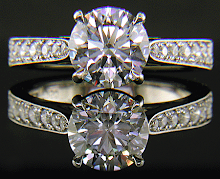As a jewelry designer, two of the most common questions I get are "what is the difference between white gold and platinum?" and "Why do you work in platinum and not white gold?"
These are both excellent questions and worthy of a detailed explanation. Here are the reasons I consider Platinum a superior metal to white gold:
- Platinum is much denser than gold so it does not wear down as quickly.
- Platinum is a purer metal (we use 90 to 95% pure platinum) whereas White gold is generally 58.5% gold (14kt) or 75% gold (18kt) with the remaining percentage a combination of alloys
- White gold is stiffer and more brittle than platinum. White gold prongs tend to snap easier than platinum prongs so they are more likely to break than platinum prongs
- Because platinum is denser, it is more difficult to pull a platinum prong (when caught on fabric) away from the stone. White gold, which is not as dense, may be easier to pull away from stone if snagged on fabric.
- Also, because white gold is more brittle, if a prong gets caught on a fiber and pulled away from the stone, it could break or snap. Platinum, because it is more malleable, will not snap as easily.....it bends easier then white gold so if it gets pulled away from the stone, it is not as likely to break....it will just stay in the new position. This allows you the opportunity to get the prong repaired by a jeweler so the stone will not come out of the setting. If a prong gets snapped or broken (ie with white gold) when it gets snagged, you could lose the diamond out of the setting.
- Platinum does not tarnish or react with air. White gold does tarnish and takes on a slightly yellowish cast as it ages. White gold is basically yellow gold that is mixed with alloys to make it white. The alloys can react with air and tarnish, leaving the yellowish cast. Platinum is a naturally white metal and the small amount of alloys used in platinum jewelry are also naturally white.
- Platinum is softer than white gold so it will get dings and scratches faster than white gold, but on a narrow band, this will not be as noticeable as it would be on a wider band.
- When you scratch or ding platinum, you don't really lose metal. It just gets pushed around like a divet on a golf course. But when you scratch or ding white gold, you generally flake off the metal and therefore lose metal. When polishing a platinum ring, the metal is pushed back into place and you have less metal loss than when you are polishing a scratched or dinged white gold piece.
- Another nice feature regarding the higher density of platinum is that even a ring of narrower proportions will still have a nice weight to it and last longer. When comparing two rings of the same dimensions (one being white gold and the other being platinum) the platinum ring will be significantly heavier.
- Finally, Platinum is far more ductile than white gold. What does this mean? It means that you can draw out platinum into a much finer filiament or wire without it snapping or breaking. White gold, on the other hand, is not as ductile and will easily snap when drawn too thin. The superior ductility of platinum allows beautiful filigree work which is seen in antique pieces from the early 1900's.
Why do most jewelers work mainly in white gold or don't work in platinum?
- One of the downsides of platinum is its higher cost. Platinum is a rarer metal and as such, platinum prices are currently about double that of gold (in raw metal forms). Couple that with the higher percentage of platinum (90 to 95%) used in jewelry (versus 58.5% to 75% pure gold) and the higher weight (density) of platinum, results in higher costs for platinum jewelry.
- Platinum requires a higher level of skill and technique in working, melting, fabricating and casting. There is certainly a higher labor cost for craftsmen that have the skill to work with platinum.
- Platinum melts at a much higher temperature than gold and therefore requires a different type of torch. It also flows differently (in melted form) than does white gold. Both of these factors mean a jeweler must first be skilled in working with the unique properties of platinum and second have the correct equipment with which to properly melt and fashion the metal.
- A jeweler that works in both platinum and gold must have two different sets of equipment and tools to avoid cross contamination of the metals thereby having a separate set of tools devoted exclusively to working on platinum. The jewelers studio must be pristine and completely absent of any other metal contaminants. Not all jewelers want to maintain two sets of tools and equipment because of the added cost and the extra care needed to prevent cross contamination.
- Many bench jewelers also find working with gold easier than platinum. Working in white gold requires less training, perhaps, and less skill and time.
Platinum is a more difficult metal to master, but once mastered, it truly is the superior metal. When fashioned and polished skillfully, it yields a beautiful finish and jewel that is likely to pass the test of time and be passed on to future generations.
To see some wonderful examples of fine quality platinum jewelry, check out some of the galleries on my website
